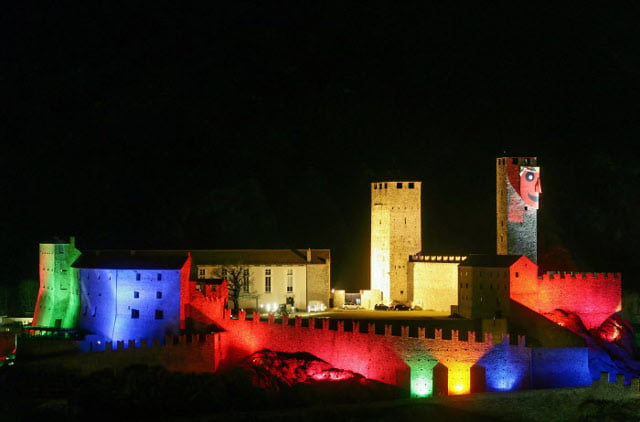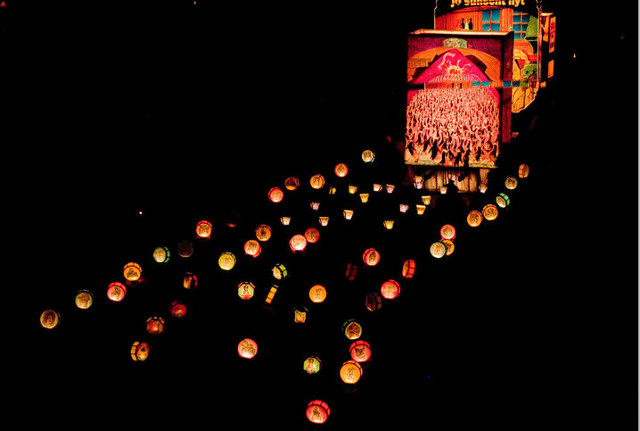Where to enjoy carnival in Switzerland this year

Carnival time is here already. The festivities kicked off in many Swiss cities on Thursday, with others to come in the next few weeks.
Lucerne’s annual party – the second biggest in Switzerland after Basel – began, as per tradition, at 5am on the day known as ‘Dirty Thursday’.
Crowds of around 15,000 people braved the zero-degree temperatures and light snowfall to watch the afternoon’s Fritschi parade, a tradition dating back to the 15th century in which life-size straw dolls are escorted through the town accompanied by carnival bands and floats.
The event kicks off six days of revelry which are concluded on Shrove Tuesday with the third carnival parade, the Monstercorso, which aims to chase the ghosts of winter away and welcome in spring.
An age-old tradition particularly in Catholic cantons, carnival is celebrated in the days leading up to Ash Wednesday and is a chance to indulge and make merry before the coming of Lent. Since Easter is early this year, so is carnival time.
Known as Fasnacht, carnival is characterized by colourful parades of people wearing elaborate costumes, carnival bands called Guggen, plus plenty of eating, drinking, throwing of confetti and general merriment.
If you’re hoping to experience carnival this year, here’s where to go:
This weekend
Guggenmusik bands will play in bars and restaurants around the city on Saturday, and then march through Littau on Sunday. The revelry continues on Monday with a big parade in the afternoon, followed by two further parades on Tuesday – one for children in the morning and then the festival’s closing event in the evening. The partying will continue until 4am on Ash Wednesday, when carnival officially ends and everyone collapses in bed for some serious recovery time.
The north-western Swiss city’s festival also kicked off on Thursday and will include parades on both Saturday and Sunday before the ‘burning of the Böögg’ on Ash Wednesday – a traditional event hailing the arrival of spring, which is also celebrated in Zurich, but not until April.
A newer festival on the block, Fribourg’s Carnaval des Bolzes will celebrate its 50th edition when it kicks off on Saturday. Taking place in the Old Town near the cathedral, the highlight is a big parade on Sunday, which begins at 2.01pm precisely and features colourful costumes, Guggen bands and decorative floats.
A must-visit in eastern Switzerland, St Gallen's Fasnacht sees the Guggen play on stages throughout the beautiful streets of the Old Town and take part in various parades through the city over the weekend, continuing until Shrove Tuesday.
Though relatively new compared to others (this is only its 43rd edition), Sion’s carnival is one of the biggest in the Valais, attracting 60,000 spectators over six days of festivities. Visit on Saturday afternoon for the highlight, a parade through town featuring 800 participants, 14 Guggen bands and 12 floats. Monday and Tuesday are dedicated to children’s events.
 Bellinzona's castles lit up during carnival. Photo: Remy Steinegger/Swiss Tourism
Known as Rabadan, Bellinzona’s carnival is the most important in the Italian-speaking canton of Ticino. It started on Thursday 8th February when the keys of the city were handed over to King Rabadan, who rules over the revellers until next Tuesday. As well as the traditional Guggenmusik, parades and children's festivities, there are also DJ sets, concerts, aperitif events and a mass risotto-eating session on the Tuesday.
February 15th-17th
While most carnivals conclude on Ash Wednesday, this one only begins then. One of the country's largest events, the Swiss capital's carnival celebrates the bear, the symbol of the city. The story starts back in November when the (symbolic) carnival bears are captured in the prison tower at Bärenplatz (Bear Square) for 111 days of slumber. On Ash Wednesday revellers gather again at Bärenplatz to ‘free' the bears from their winter hibernation. A procession of jesters, musicians and traditional drummers – called Ychüblete – then proceeds through the city, sparking three days of revelry.
February 19th-22nd
Bellinzona's castles lit up during carnival. Photo: Remy Steinegger/Swiss Tourism
Known as Rabadan, Bellinzona’s carnival is the most important in the Italian-speaking canton of Ticino. It started on Thursday 8th February when the keys of the city were handed over to King Rabadan, who rules over the revellers until next Tuesday. As well as the traditional Guggenmusik, parades and children's festivities, there are also DJ sets, concerts, aperitif events and a mass risotto-eating session on the Tuesday.
February 15th-17th
While most carnivals conclude on Ash Wednesday, this one only begins then. One of the country's largest events, the Swiss capital's carnival celebrates the bear, the symbol of the city. The story starts back in November when the (symbolic) carnival bears are captured in the prison tower at Bärenplatz (Bear Square) for 111 days of slumber. On Ash Wednesday revellers gather again at Bärenplatz to ‘free' the bears from their winter hibernation. A procession of jesters, musicians and traditional drummers – called Ychüblete – then proceeds through the city, sparking three days of revelry.
February 19th-22nd
 The Morgestraich. Photo: Swiss Tourism
The biggest and most important carnival in Switzerland is this one in Basel, which waits until last to trump the rest with three days of extreme partying. So old and important is it that it was recently inscribed onto Unesco’s intangible heritage list. The fun starts at 4am on the Monday after Ash Wednesday when the city's lights are extinguished and lanterns and decorative floats depicting topical themes light up the streets in a parade known as ‘Morgestraich’. For the next three days the city centre is taken over by costumed revellers who have spent the entire year preparing their outfits. More than 10,000 masked participants parade throughout the city in two main processions on the Monday and Wednesday.
The Morgestraich. Photo: Swiss Tourism
The biggest and most important carnival in Switzerland is this one in Basel, which waits until last to trump the rest with three days of extreme partying. So old and important is it that it was recently inscribed onto Unesco’s intangible heritage list. The fun starts at 4am on the Monday after Ash Wednesday when the city's lights are extinguished and lanterns and decorative floats depicting topical themes light up the streets in a parade known as ‘Morgestraich’. For the next three days the city centre is taken over by costumed revellers who have spent the entire year preparing their outfits. More than 10,000 masked participants parade throughout the city in two main processions on the Monday and Wednesday.
Comments
See Also
Lucerne’s annual party – the second biggest in Switzerland after Basel – began, as per tradition, at 5am on the day known as ‘Dirty Thursday’.
Crowds of around 15,000 people braved the zero-degree temperatures and light snowfall to watch the afternoon’s Fritschi parade, a tradition dating back to the 15th century in which life-size straw dolls are escorted through the town accompanied by carnival bands and floats.
The event kicks off six days of revelry which are concluded on Shrove Tuesday with the third carnival parade, the Monstercorso, which aims to chase the ghosts of winter away and welcome in spring.
An age-old tradition particularly in Catholic cantons, carnival is celebrated in the days leading up to Ash Wednesday and is a chance to indulge and make merry before the coming of Lent. Since Easter is early this year, so is carnival time.
Known as Fasnacht, carnival is characterized by colourful parades of people wearing elaborate costumes, carnival bands called Guggen, plus plenty of eating, drinking, throwing of confetti and general merriment.
If you’re hoping to experience carnival this year, here’s where to go:
This weekend
Guggenmusik bands will play in bars and restaurants around the city on Saturday, and then march through Littau on Sunday. The revelry continues on Monday with a big parade in the afternoon, followed by two further parades on Tuesday – one for children in the morning and then the festival’s closing event in the evening. The partying will continue until 4am on Ash Wednesday, when carnival officially ends and everyone collapses in bed for some serious recovery time.
The north-western Swiss city’s festival also kicked off on Thursday and will include parades on both Saturday and Sunday before the ‘burning of the Böögg’ on Ash Wednesday – a traditional event hailing the arrival of spring, which is also celebrated in Zurich, but not until April.
A newer festival on the block, Fribourg’s Carnaval des Bolzes will celebrate its 50th edition when it kicks off on Saturday. Taking place in the Old Town near the cathedral, the highlight is a big parade on Sunday, which begins at 2.01pm precisely and features colourful costumes, Guggen bands and decorative floats.
A must-visit in eastern Switzerland, St Gallen's Fasnacht sees the Guggen play on stages throughout the beautiful streets of the Old Town and take part in various parades through the city over the weekend, continuing until Shrove Tuesday.
Though relatively new compared to others (this is only its 43rd edition), Sion’s carnival is one of the biggest in the Valais, attracting 60,000 spectators over six days of festivities. Visit on Saturday afternoon for the highlight, a parade through town featuring 800 participants, 14 Guggen bands and 12 floats. Monday and Tuesday are dedicated to children’s events.

Bellinzona's castles lit up during carnival. Photo: Remy Steinegger/Swiss Tourism
Known as Rabadan, Bellinzona’s carnival is the most important in the Italian-speaking canton of Ticino. It started on Thursday 8th February when the keys of the city were handed over to King Rabadan, who rules over the revellers until next Tuesday. As well as the traditional Guggenmusik, parades and children's festivities, there are also DJ sets, concerts, aperitif events and a mass risotto-eating session on the Tuesday.
February 15th-17th
While most carnivals conclude on Ash Wednesday, this one only begins then. One of the country's largest events, the Swiss capital's carnival celebrates the bear, the symbol of the city. The story starts back in November when the (symbolic) carnival bears are captured in the prison tower at Bärenplatz (Bear Square) for 111 days of slumber. On Ash Wednesday revellers gather again at Bärenplatz to ‘free' the bears from their winter hibernation. A procession of jesters, musicians and traditional drummers – called Ychüblete – then proceeds through the city, sparking three days of revelry.
February 19th-22nd

The Morgestraich. Photo: Swiss Tourism
The biggest and most important carnival in Switzerland is this one in Basel, which waits until last to trump the rest with three days of extreme partying. So old and important is it that it was recently inscribed onto Unesco’s intangible heritage list. The fun starts at 4am on the Monday after Ash Wednesday when the city's lights are extinguished and lanterns and decorative floats depicting topical themes light up the streets in a parade known as ‘Morgestraich’. For the next three days the city centre is taken over by costumed revellers who have spent the entire year preparing their outfits. More than 10,000 masked participants parade throughout the city in two main processions on the Monday and Wednesday.
Join the conversation in our comments section below. Share your own views and experience and if you have a question or suggestion for our journalists then email us at [email protected].
Please keep comments civil, constructive and on topic – and make sure to read our terms of use before getting involved.
Please log in here to leave a comment.